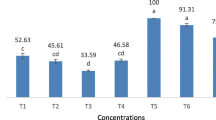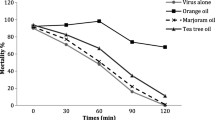Abstract
Mortality ofHeliothis armigera (Hbn.) larvae due to nuclear polyhedrosis virus (NPV) was significantly higher onGossypium barbadense (cv. DCH 32) than onG. birsutum (cv. LRA 5166) andG. arboreum (cv. K 10). A positive correlation existed between leaf area consumed and NPV mortality of the larvae. Among the three dosages of NPV tested, 2.16×108 polyhedral occlusion bodies (POB)/ml as ultra low volume application caused the maximum larval mortality. Probit analysis of time mortality responses showed that the LT50 was lower onG. barbadense than on other two species tested.
Zusammenfassung
Die Mortalität vonHeliothis armigera (Hbn.)-Larven, hervorgerufen durch den Kernpoledrose-Virus (NPV), war auf der Baumwolle-SorteGossypium barbadense DCH 32 signifikant höher als auf den beiden SortenG. hirsutum LRA 5166 undG. arboreum K 10. Es bestand eine positive Korrelation zwischen der verzehrten Blattfläche und der NPV-Mortalität der Larven. Innerhalb der 3 getesteten NPV-Dosierungen verursachten 2.16×108 Polyeder/ml bei ULV (ultra low volume)-Anwendung die höchste Larvenmortalität. Die Probitanalyse zeigt, daß die LT 50 der Larven anG. barbadense niedriger war als an den beiden anderen Baumwolle-Sorten.
Similar content being viewed by others
References
Bell, M. R.;Romine, C. L., 1985: Microbial control ofHeliothis spp. (Lepidoptera: Noctuidae) in cotton: dosage and management trials. J. Entomol. Sci.20, 146–151.
Chapman, A. J.;Bell, R. A., 1967: Field tests with the nuclear polyhedrosis virus for control ofHeliothis spp. in the Southern high Texas, 1964. J. Econ. Entomol.60, 655–656.
Dhandapani, N.;Jayaraj, S.;Rabindra, R. J., 1987: Efficacy of ULV application of nuclear polyhedrosis virus with certain adjuvants for the control ofHeliothis armigera (Hbn.) on cotton. J. Biol. Control,1, 111–117.
Elleman, C. J.;Entwistle, P. F., 1982: A study of glands on cotton responsible for high pH and cation concentration of leaf surface. Ann. appl. Biol.100, 553–558.
Elleman, C. J.;Entwistle, P. F., 1985a: The effects of magnesium ions on the solubility of polyhedral inclusion bodies and its possible role in the inactivation of the nuclear polyhedrosis virus ofSpodoptera littoralis by the cotton leaf gland exudate. Ann. appl. Biol.106, 93–100.
Elleman, C. J.;Entwistle, P. F., 1985b: Inactivation of a nuclear polyhedrosis virus on cotton by substances produced by cotton leaf glands. Ann. appl. Biol.106, 83–92.
Fernandez, A. T.;Graham, H. M.;Lukefebr, M. J.;Bullock, H. R.;Hernandez, N. S., Jr., 1969: A field test comparing resistant varieties plus applications of polyhedral virus with insecticides for control ofHeliothis spp. and other pests of cotton. J. Econ. Entomol.62, 173–177.
Finney, D. J., 1962: Probit analysis. A statistical treatment of the sigmoid response curve. 2nd ed. Cambridge Univ. Press, London, 318 p.
Nanthagopal, R., 1987: Studies of life tables and distribution of cotton bollworms. M. Sc. (Ag.) Thesis, Tamil Nadu Agricultural University, Coimbatore, India, 111 p.
Rabindra, R. J.;Jayaraj, S., 1986: Efficacy of NPV with adjuvants as high volume and ultra low volume applications againstHeliothis armigera (Hbn.) on chickpea and influence of varieties on virus control. Newsl. International Heliothis Biol. Control work Group.5, 6.
Santharam, G.;Jayaraj, G., 1987: Effects of host plant and site of application on the infectivity of nuclear polyhedrosis virus toSpodoptera litura larvae. J. Biol. Control1, 39–43.
Shorey, H. H.;Hale, R. L., 1965: Mass rearing of the larvae of nine noctuide species on a simple artificial medium. J. Econ. Entomol.58, 522–524.
Sithanantham, S., 1987: Results of recent evaluation ofHeliothis NPV on pigeon pea at ICRISAT. Newsl. International Heliothis Biol. Control work Group6, 12.
Tuan, S. J.;Tang, L. C.;Hou, R. F., 1989: Factors affecting pathogenicity of NPV preparations to the corn earworm,Heliothis armigera. Entomophaga34, 541–549.
Yong, S. Y.;Yearian, W. C.;Kim, K. S., 1977: Effect of dew from cotton and Soybean foliage on activity ofHeliothis nuclear polyhedrosis virus. J. Invertebr. Pathol.29, 105–111.
Author information
Authors and Affiliations
Additional information
With 3 figures and one table
Rights and permissions
About this article
Cite this article
Dhandapani, N., Jayaraj, S. & Rabindra, R.J. Laboratory studies on the efficacy of nuclear polyhedrosis virus againstHeliothis armigera (Hbn.) on some cotton cultivars. Anz. Schadlingskde., Pflanzenschutz, Umweltschutz 66, 96–100 (1993). https://doi.org/10.1007/BF01906819
Issue Date:
DOI: https://doi.org/10.1007/BF01906819




